Brief

한눈에 보기
- After steadily watching their traditional scale advantages erode, Southeast Asia’s conglomerates are now underperforming their pure play competitors in total shareholder returns.
- A subset of conglomerates, however, have continued to outperform their peers and pure plays throughout the 16 years that we have been tracking conglomerate performance. These conglomerates have demonstrated an ability to adapt to change—whether that’s the end of a high-growth period or the profound challenges introduced by Covid-19.
- Winners drive each business to its full potential, actively manage portfolios and reimagine their business models for the new realities.
We have been tracking Southeast Asia’s conglomerates for 16 years, and what we long predicted has finally happened.
As markets have steadily become more competitive, the old advantages of size, diversification and close government connections that once fueled decades of success for the region’s conglomerates have now turned to disadvantages. For the first time, pure plays overtook conglomerates in multiyear shareholder performance.
In an environment of shrinking shareholder returns across all Southeast Asia markets, the average conglomerate has just about kept pace with the average pure play from 2010 to 2018. Yet, looking at 2014 to 2018, it is clear that the gap is widening (see Figure 1). From 2010 to 2014, the annualized total shareholder return (TSR) for conglomerates outperformed pure plays by 3 percentage points. Since then, however, they have underperformed pure plays by a substantial 6 percentage points. (TSR is defined as stock price changes assuming the reinvestment of cash dividends.)
The average annualized total shareholder return for conglomerates outperformed that of pure plays during the first half of the decade; then, the trend reversed

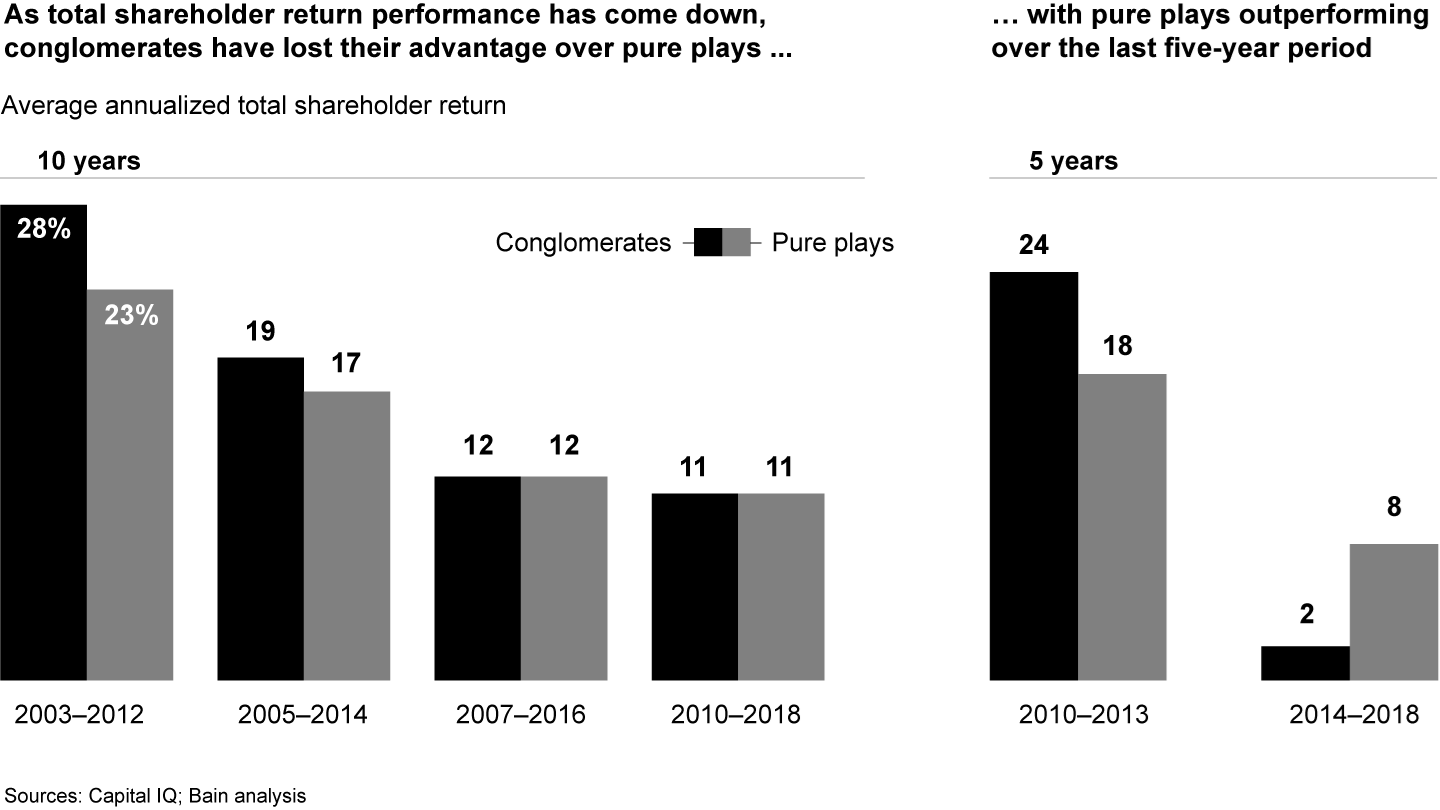
The Covid-19 crisis now throws a massive wild card into the picture. Will conglomerates’ diversification help them survive and thrive? Will the crisis be a catalyst for change? Or will they struggle to take the decisive steps required to ensure survival and reposition for success? Working with conglomerates and conducting in-depth interviews with some of the leading groups across Southeast Asia has revealed some distinct patterns.
Most conglomerates fail to adapt to change
First, it is important to look at performance over the past decade. In some ways, the region’s conglomerates did well in the first half of the decade simply because everybody else did—a rising tide lifts all boats. It was a time of high growth, and many conglomerates benefited from operating in high-growth sectors—and by being there first.
But when the high-growth era slowed in 2015, many conglomerates did not adapt to the change. Slower than their pure play counterparts to face the reality of sluggish economic growth, many in the region failed to shift their focus to margin expansion and cost discipline. Our research found that margin expansion accounted for 5% of the 8% of annualized TSR gains for pure plays between 2014 and 2018, yet conglomerates did not get any TSR increase from margins over the same period.
Also from 2014 to 2018, many conglomerates turned their backs on M&A, which had been a foundation of their success in earlier years. The average number of annual M&A deals among Southeast Asia’s conglomerates dropped from a high of 2.6 in 2013 to 1.4 in 2018. Only the best performers took decisive action to reshape their portfolios and become leaders in their primary industries. In contrast, the majority of Southeast Asia’s conglomerates hesitated to reshape their portfolios, which then saddled them with weak competitive positions as well as overexposure to low-growth industries.
Enter the “all-weather stars”
The true test of a conglomerate is its ability not only to adapt to changes—including long-simmering ones such as the end of the high-growth era and black swans such as Covid-19—but also to use changes as opportunities for reinvention. Some have risen to the task. In fact, the best conglomerates continue to outperform handsomely, giving even the top pure plays a run for their money.
A subset of those outperformers have managed to do so throughout all 16 years of our research. The difference is impressive: The top quartile of conglomerates achieved a 26% annualized TSR from 2010 to 2018 vs. a −6% TSR for the bottom quartile. It is even more dramatic when you consider the absolute impact over that period—more than sixfold growth for the top quartile vs. −40% for the bottom. We call these winners “all-weather stars,” and included among them are companies such as JG Summit in the Philippines, Sinar Mas in Indonesia, Charoen Pokphand (CP Group) in Thailand and Hong Leong in Malaysia.
So what is different about these all-weather stars?
First, they are all family controlled, which gives them the ability to take a long-term perspective while being disciplined about where and how they participate (see Figure 2). As a senior executive at one of Indonesia’s leading conglomerates flatly stated, “We’ve been through numerous crises, and we’re going to be around after this pandemic. We’re here for the long term.” Conglomerates such as this one didn’t become so successful just by picking the right sectors and riding waves of growth. Instead, all-weather stars compete broadly and manage to outperform even in low-return industries such as agriculture.
Family-controlled conglomerates, on average, deliver higher shareholder returns

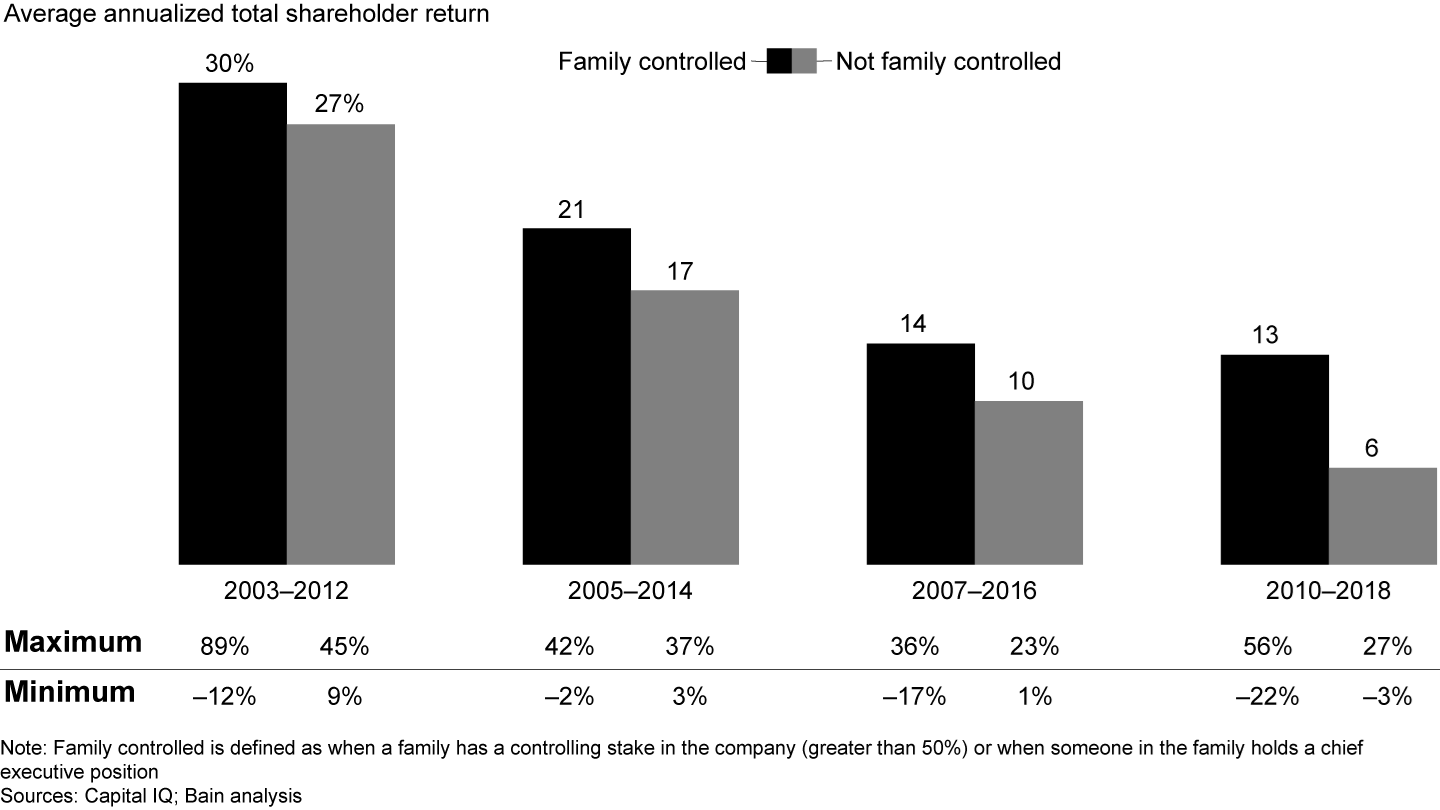
All-weather stars are unique in that they have clearly defined their parenting advantage—namely, the management spikes that allow a conglomerate to add value to each element of its portfolio. For example, Sinar Mas’s business units operate largely autonomously yet have access to capital and short-term borrowing, with the conglomerate effectively playing an internal bank role. This parenting model helped Sinar Mas achieve a 24% annualized average TSR from 2010 to 2018. For Masan Group, one parenting advantage is its consistently solid balance sheet and strong central M&A capabilities. Acquisitions made by following a reliable playbook have been at the heart of Masan’s growth. Its access to long-term capital such as equity and local debt allows the Vietnam conglomerate to strike major deals when its competitors are overstretched.
Investing to attract and train management is a parenting advantage for conglomerates such as the CP Group, where Senior Chairman Dhanin Chearavanont has built the CP Leadership Institute, a world-class training center in Khao Yai.
While all-weather stars may depend on different parenting advantages, they tend to follow the same classic crisis playbook for coming out stronger from each downturn—a playbook that requires them to protect, recover and retool for a new world. In conglomerates, as in pure plays, the actions taken during a downturn dictate the long-term future. Winners and losers are determined during turbulent times.
Here’s what the winners do differently.
Drive each business to its full potential. A senior executive with one of Indonesia’s leading conglomerates said that his company weathered the commodity downturn of 2015 and came out stronger by aggressively reducing costs—not only trimming the fat but also using the momentum to optimize costs (see Figure 3). All-weather stars act swiftly to protect their business by reducing costs early and by aggressively managing liquidity and balance sheets.
Conglomerates that have successfully reduced operating expenditures have also outperformed their peers

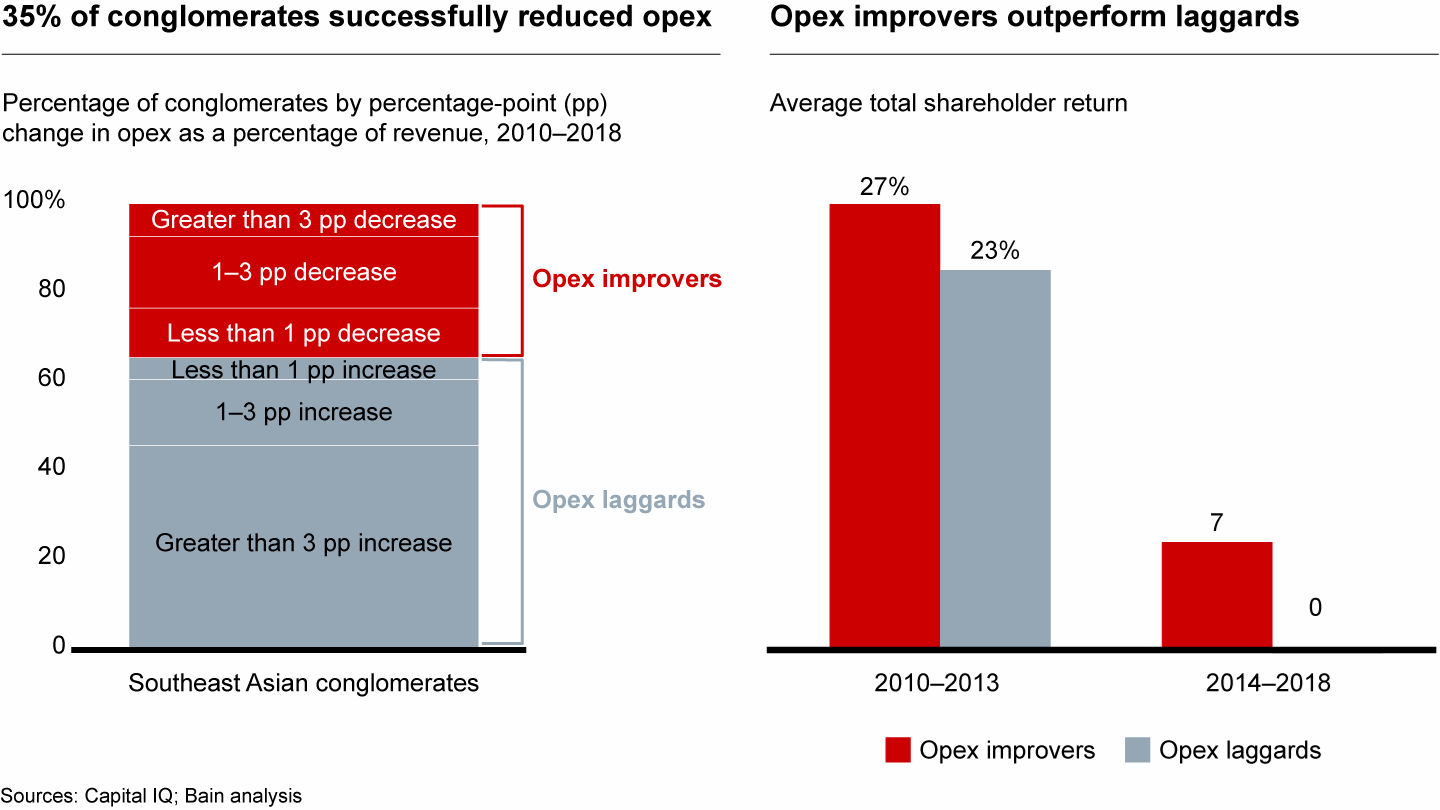
Indeed, we have consistently observed that the best conglomerates outinvest the competition in downturns, and as a result, they emerge stronger when the tide turns (see Figure 4). During today’s Covid-19 crisis, this could mean boosting customer engagement by developing a seamless omnichannel experience or by building big data analytics to better serve customers. It could mean investing in process digitization, operations automation and supply chain resilience. One Indonesia conglomerate has dedicated 150 people to developing a digital platform to connect consumers across its businesses.
Conglomerates that increase capital expenditures throughout the economic cycle tend to deliver higher shareholder returns

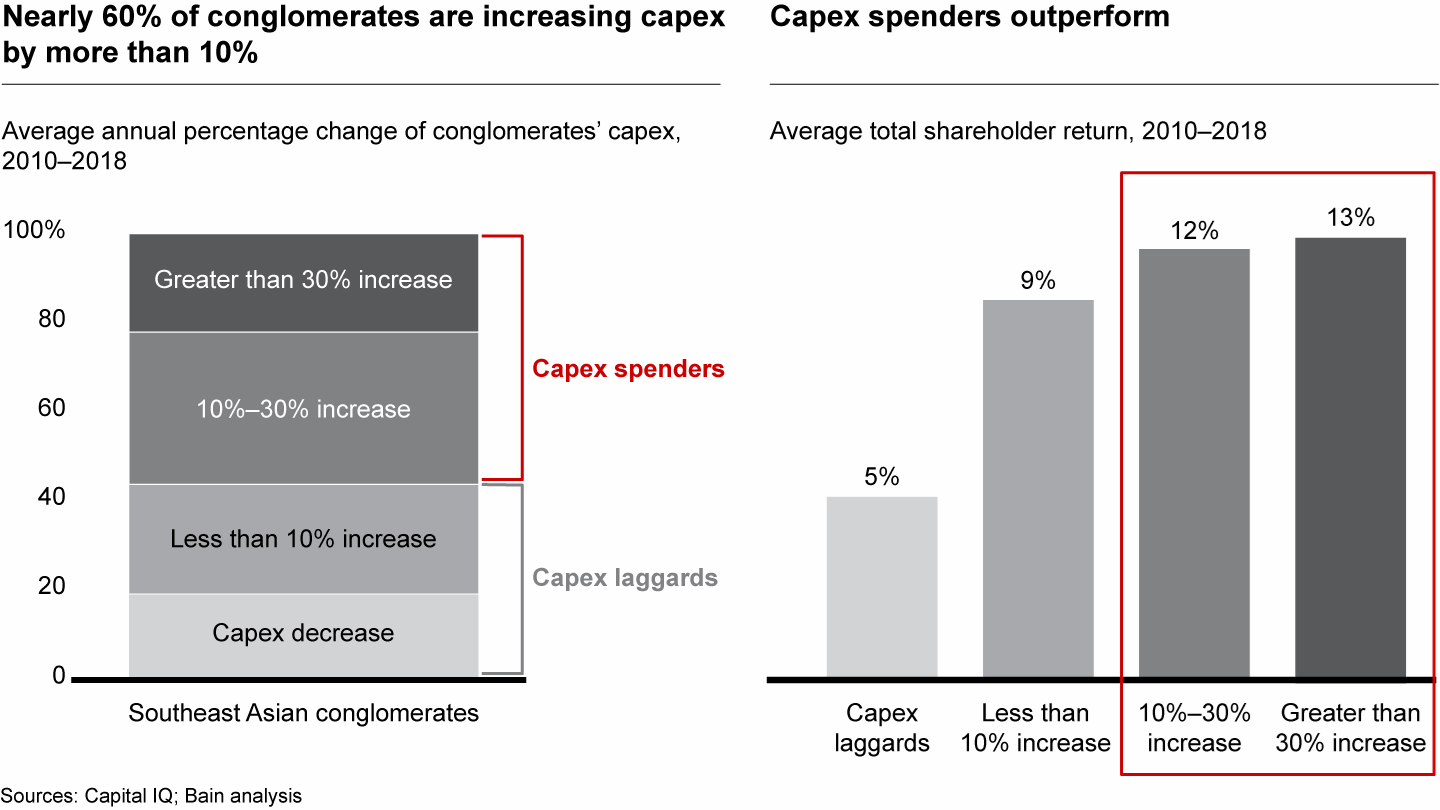
An executive at another leading conglomerate said, “While we don’t foresee fundamental changes to our portfolio through this crisis, the way we do business will for sure change. We have to reduce costs, remove layers and go digital across the board.” The pandemic forced many teams to shed their established ways of working and to adopt leaner and more agile management practices—and several organizations are determined to cultivate these operating methods into the new normal. One thing is certain: Forward-looking conglomerates will not waste this crisis.
Actively manage the portfolio. According to a leader with a Singapore conglomerate, “a downturn is a time to move faster and more decisively,” adding that the conglomerate looks for potential deals during the downturn. It is a time to exit unattractive positions, consolidate positions and enter new industries.
Preparing for change means knowing which business assets position the portfolio for long-term sustainable growth, and which don’t. It means being able to answer the fundamental question: Why are we the best owner of these assets?
Portfolio management has been key to the remarkable success of CP Group. The conglomerate maintains consistent revenue growth through vertical integration within its core agriculture business and by diversifying its portfolio beyond the core. Consider its expansion into retail and telecommunications. Such aggressive portfolio moves in the 1980s and 1990s helped CP sustain its high performance during the commodities downturn of 2014 and 2015. While others in agriculture endured dramatic losses, CP Food suffered less, thanks to vertical integration and support from its retail and telecom businesses. Overall, CP Group’s revenue grew by an average of 16% across all business units from 2011 to 2018. The conglomerate is continuing on this path with its planned $10.6 billion acquisition of UK-based grocery retailer Tesco’s Southeast Asia business.
Covid-19 raises new questions about the future direction of many industries. Will the customer behaviors we have seen throughout the crisis accelerate or revert? How might governments and the public sector reshape the rules of the game for our industry? How will Covid-19 shift profit pools and overall attractiveness?
Reshaping the business portfolio often involves M&A and divestitures. We have been tracking the influence of M&A on corporate performance for two decades. The evidence is consistent over the years: Companies that are active in M&A, the data shows, outperform those that stay away from deals. Companies that do the most deals and those in which cumulative deal making accounts for a large fraction of their market capitalizations perform best of all.
We refer to companies that participate in more than two deals per year and those with deals amounting to more than 50% of the buyer’s market capitalization as “mountain climbers.” Among Southeast Asia’s conglomerates, those within this group achieved an annualized average TSR of 11.2% from 2010 to 2018. In contrast, companies participating in fewer than two deals a year representing less than 50% of their market cap—we call them “selected fill-ins”—achieved an 8.5% TSR over that period.
For conglomerates that are ready and that have strong balance sheets, the next few years should offer interesting opportunities to accelerate their journey toward leadership. In the words of an executive at a Malaysia conglomerate, “Several months into the crisis, we are in execution mode on our downturn action plan and now setting our sights on M&A opportunities.”
Reimagine the conglomerate model. All-weather stars show us what excellence looks like in the face of rapid change and unforeseen disruption. If we have learned anything from our research, it is that in the current environment, yesterday’s inflexible conglomerate model is the surest way to fall behind competing conglomerates and ever-strengthening pure plays (see Figure 5).
Three elements for reinventing the conglomerate model

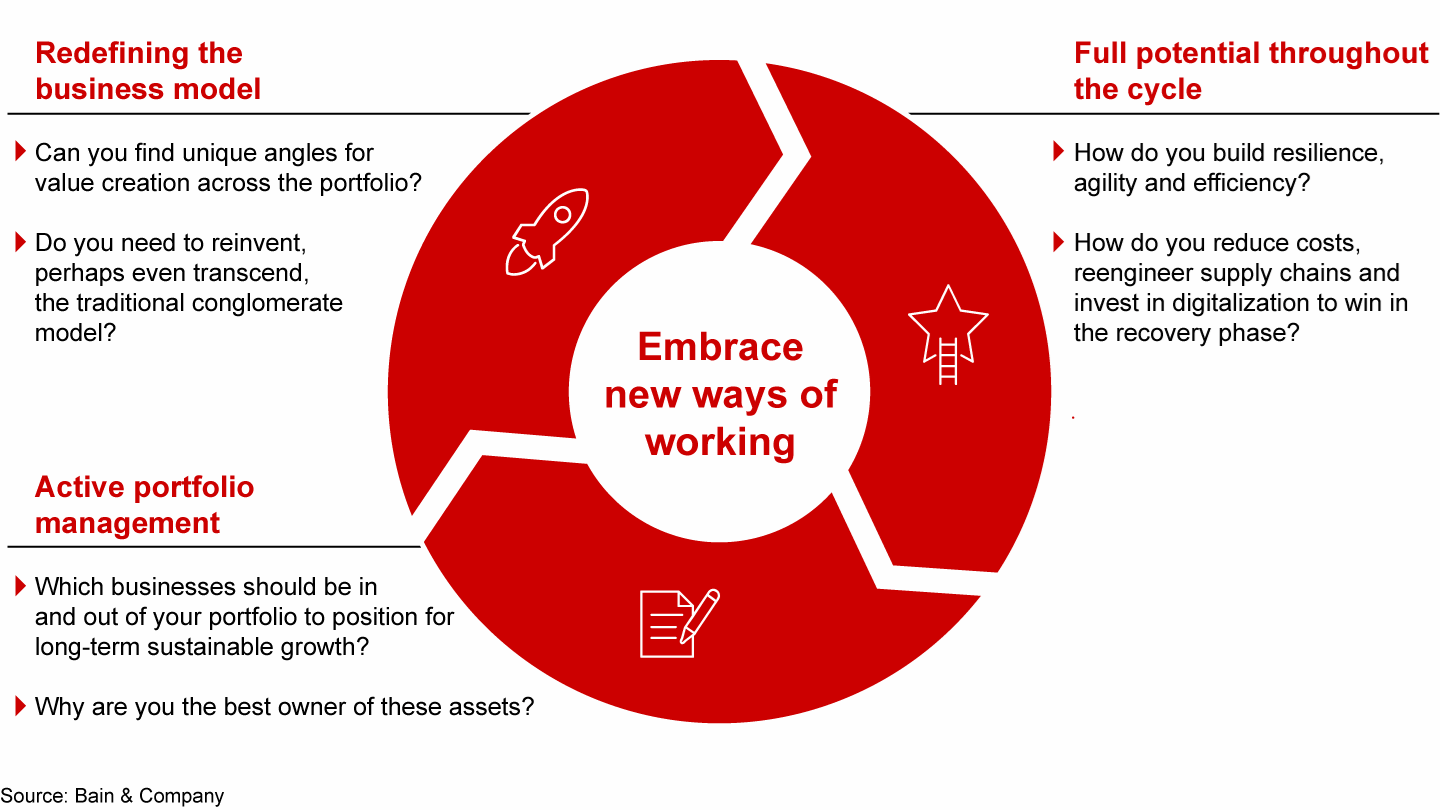
At the basic level, conglomerates have four archetypes from which to choose: holding companies, diversified groups, cohesive groups and integrated groups (see Figure 6). Determining which of these archetypes is most viable is something that will become more evident as the region’s markets evolve—and it is a question that we will continue to track in our ongoing research.
Four conglomerate archetypes


Holding companies are conglomerates with an unrelated set of businesses. The center decides what businesses to hold, sell and buy; makes key financial decisions; and appoints CEOs and boards. This works when the businesses are truly diverse, with no or little synergies, and when decision making is purely financially driven. Private equity groups are the perfect example of this model. Given private equity’s abundant dry powder (uninvested capital), ability to attract top talent through performance-based compensation, and access and willingness to leverage, it is becoming increasingly hard for conglomerates to compete using this model.
Diversified groups have broad portfolios but with some group value added through best practice sharing, such as talent development or operational excellence. This is the original Western conglomerate model pioneered by the likes of General Electric or United Technologies. Such businesses have struggled to keep up with large and well-managed pure plays and well-financed activist investors—in fact, United Technologies spun off Otis Worldwide and Carrier Global earlier this year. Yet this model remains prevalent in emerging economies in Southeast Asia, where traditional advantages, such as access to finance and talent as well as strong government relations, continue to provide an advantage. We worry that these diversified groups will stumble as markets inevitably become more competitive, pure plays scale up and disruption affects traditional moneymaking businesses such as banking and telecommunications.
Cohesive groups have portfolios with a common theme, such as engineering or consumer services. The center shapes strategy, pursues synergies (for instance, shared services or customer relationship management) and drives capabilities across the group (for example, digital). Consider how Sime Darby spun off its two largest units, Plantation and Property, into separately listed companies, making the conglomerate a more streamlined version of itself. Such moves may only provide temporary relief, however, as the dual challenges of focused pure play competitors and business model disrupters are likely to continue. Cohesive groups will have to continue to prove to investors that they can create value throughout various economic cycles by competing at the business unit level and by delivering synergies across businesses.
Integrated groups are those that transcend the traditional conglomerate model. They have portfolios with a unified purpose and integrated strategy. The center drives strategy and execution. This is new and somewhat experimental terrain for conglomerates, as it typically requires business model reinvention, portfolio cleanup, and significant forays into new businesses and technologies. Ultimately, conglomerates might need to pursue this higher synthesis to avoid being broken apart into separate businesses—and truly to thrive over the long term.
Companies can become integrated groups in three ways.
- They can create a common purpose and a shared business model. This is what Masan did via its focus on consumers and its vision of creating a consumer ecosystem in rapidly emerging Vietnam.
- They can vertically integrate. As we mentioned, CP Group’s vertical integration, centered around its agriculture business (from feed to farm to food to store), has allowed it to sustain 16% revenue growth across economic cycles.
- They can pursue platform plays. That is why conglomerates such as Astra, CP Group and others capture, analyze and use data to sell more effectively, cross-sell, and develop new, data-centric business models. It can be a powerful model, and, indeed, platforms power seven of the top-performing companies in the world. It is also extremely difficult to implement successfully—it requires defining the perfect customer value proposition and monetization model, breaking through organizational silos and regulatory obstacles, and access to the right technology and capabilities. “If we don’t transform ourselves,” said a senior executive with one of Southeast Asia’s fastest-growing conglomerates, “we will be eliminated.”
Now, more than ever, conglomerates need to do the following:
- Reduce costs, reengineer supply chains and invest in digitalization to win in the recovery phase. Downturns further separate winners from losers, and this time will not be any different.
- Embrace new, leaner and more agile ways of working. And use them to address the real-time imperative that the crisis has created.
- Reshape the portfolio for a post–Covid-19 world. This means both acquiring and divesting given the widely changing outlook among many industries.
- Find unique angles for value creation across the portfolio. And use them to reinvent and perhaps even transcend the traditional conglomerate model to compete in increasingly competitive markets.
Covid-19 suddenly and profoundly intensified the game for conglomerates, making it less a matter of falling behind and more one of sheer survival. But the crisis also provides a vital opportunity for a reset and a new lease on life. In that sense, it is a watershed moment.